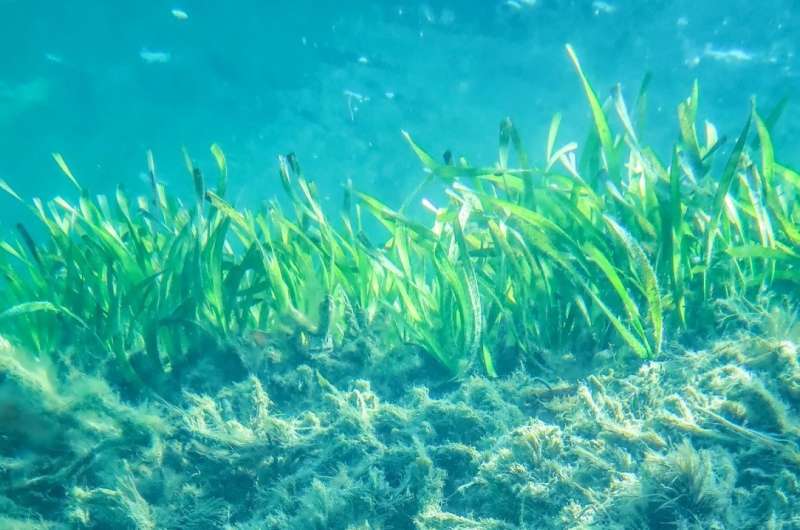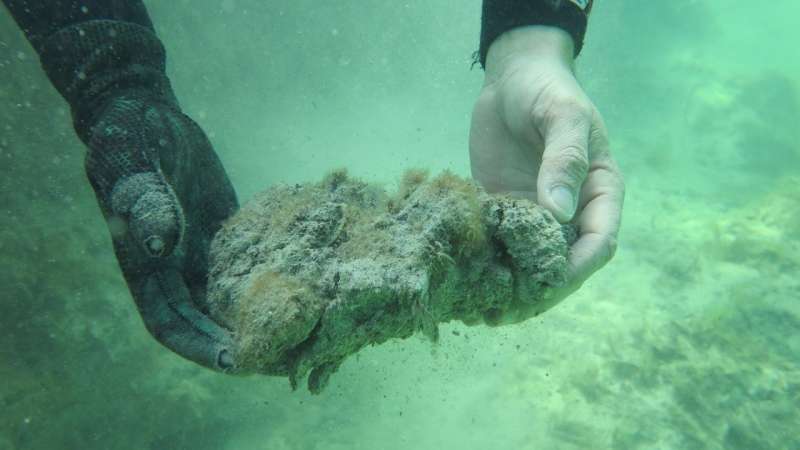Climate change threatens world's largest seagrass carbon stores

In the summer of 2010-2011, Western Australia experienced an unprecedented marine heat wave that elevated water temperatures two to four degrees Celsius above average for more than two months. Researchers from the Institute for Environmental Science and Technology at the Universitat Autònoma de Barcelona (ICTA-UAB) in collaboration with scientists from Australia, Spain, Malaysia, the United States and the Kingdom of Saudi Arabia became alert to major carbon dioxide (CO2) emissions resulting from the loss of seagrass meadows at Shark Bay—an internationally recognized World Heritage Area and one of the largest remaining seagrass ecosystems on Earth.
The loss of seagrass at Shark Bay after the 2010-2011 marine heatwave released up to 9 million metric tons of CO2 into the atmosphere over the three years following the event. This amount is roughly the equivalent to the annual CO2 output of 800,000 homes, two average coal-fired power plants or 1,600,000 cars driven for 12 months. It also potentially raised Australia's annual estimate of national land-use change for CO2 emissions by up to 21 percent.
ICTA-UAB and Edith Cowan University (ECU)-led international research has estimated that Shark Bay has the largest carbon stores reported for a seagrass ecosystem, containing up to 1.3 percent of the total carbon stored in seagrass soils worldwide.
Researchers initially mapped 70 percent of this UNESCO World Heritage Site in 2014 and found a 22 percent loss of seagrass habitat as compared with the 2002 baseline, equivalent to a 1,100 km2 loss of meadows. "The widespread losses in the summer of 2010-2011 were unprecedented. The net loss of seagrass extent was accompanied by a dramatic shift in seagrass cover. What remained was sparser with 'dense' seagrass areas that had declined from 72 percent in 2002 to 46 percent in 2014," explains Ariane Arias-Ortiz, Ph.D. candidate at ICTA-UAB and first author of the work.
"This decrease is significant because seagrass meadows rank among the most intense CO2 sinks in the biosphere, giving them the name 'blue carbon ecosystems.' They take up and store CO2 in their soils and biomass through biosequestration. The carbon that is locked in the soils may remain there for millennia if seagrass ecosystems, which offer physical protection to these stocks, remain intact," says Professor Carlos M. Duarte, professor at King Abdullah University of Science and Technology and co-advisor to the Ph.D. thesis of the lead author.

Dr. Oscar Serrano, ECU researcher and also a co-author adds "When you have an event such as the losses at Shark Bay, not only do you lose the benefits of CO2 uptake by seagrasses but also any carbon sequestered by the seagrasses is released back into the atmosphere as CO2 when the seagrasses decompose."
"Although seagrass meadows are amenable to restoration, more importantly, we should be looking at avoiding the loss of the seagrass carbon stores because CO2 emissions from degraded seagrass ecosystems greatly surpass the annual sequestration capacity of healthy meadows" concludes Arias-Ortiz.
"With climate change forecasted to increase the frequency of extreme weather events, the permanence of these carbon stores becomes compromised, further stressing the importance of reducing greenhouse gas emissions and implementing management actions to avoid adverse feedback on the climate system."
To conduct the study, researchers used satellite imagery processed by the Department of Biodiversity, Conservation and Attractions of Western Australia, in situ sampling from 50 sites and soil modelling to make their calculations of potential CO2 release.
While the Shark Bay Marine Reserves Management Plan 1996-2006 offers protections against local threats such as overfishing and nutrient inputs from industry, agriculture and tourism, there is currently nothing in place to deal with global threats, such as heat waves."We need to advance our understanding of how seagrass ecosystems, especially those living close to their thermal tolerance limit, will respond to threats from global change, both those from direct pressures and those from interactions with local pressures," said Prof. Paul Lavery ECU researcher and co-author.
"We have seen how quickly losses can occur, and once destroyed, the capacity of seagrass meadows to recover is limited and slow, and largely depends on the arrival of seeds or seedlings."
Plans for future catastrophes might include removing seagrass detritus to prevent phytoplancton blooms and growth of algae, which consume oxygen in the water column and attenuate light. If seagrasses are lost, impacted areas could be restored through reseeding and repopulation with genetically more resilient types of seagrass.
More information: A marine heatwave drives massive losses from the world's largest seagrass carbon stocks, Nature Climate Change, nature.com/articles/doi:10.1038/s41558-018-0096-y
Journal information: Nature Climate Change





















